


|
|
|
|||||||||||||||
|
|
||||||||||||||||
|
|
|||||
|
|
Warwick Warwick Castle
Following the Norman conquest of England in 1066, William the Conqueror established a series of defensive positions around the country and in 1068 a motte-and-bailey castle was constructed at Warwick. A motte-and-bailey castle consists of a mound – on which usually stands a keep or tower – and an enclosed courtyard, which is known as a bailey. Henry de Beaumont was appointed as constable of the castle and in 1088, William made him the first Earl of Warwick. In 1153, the wife of Roger de Beaumont, the 2nd Earl of Warwick, surrendered the castle to Henry of Anjou (Later King Henry II) after being tricked into believing that her husband was dead, later during the reign of Henry II (1154–89), the motte-and-bailey was replaced with a stone keep castle, with the buildings constructed against the curtain wall. During the Barons' Rebellion of 1173–74, the Earl of Warwick remained loyal to King Henry II, and the castle was used to store provisions. Between 1330 -1360 the castle defences were significantly enhanced. This included the construction of a gatehouse, which incorporated two drawbridges, a gate, and portcullises. 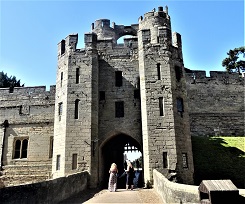 It also incorporated murder holes that were used for firing arrows or dropping rocks or boiling liquids on to assaulting troops. It also incorporated murder holes that were used for firing arrows or dropping rocks or boiling liquids on to assaulting troops. 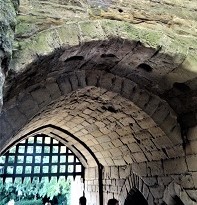 Constructed at that time was a barbican, which is a form of fortified gateway, and a tower on either side of the reconstructed wall, these being Caesar's Tower which consisted of three floors and stood 147 feet high, and Guy's Tower with its five floors it stands 128 feet high, both of these towers were residential, although Caesar’s Tower also contained a basement dungeon. It was also at this time that Watergate Tower was constructed. Throughout the Middle Ages, The Earls of Warwick played significant parts in history. During the Hundred Year War with France in the 14th and 15th century, Thomas de Beauchamp, 11th Earl of Warwick, commanded troops at the battle of Crecy and Poitiers, while Richard de Beauchamp, the 13th Earl of Warwick, was Captain of Calais in France and supervised the trial of Joan of Arc. During the Wars of the Roses (1455-1487) Richard Neville, the 16th Earl of Warwick, obtained the name “the Kingmaker” having helped Henry VI to power. He was killed at the Battle of Barnet (1471) when defeated by Edward IV. In the early 1480s, King Richard III constructed the Bear and Clarence Towers, although these were not finished due to his death in 1485. These would include their own well and ovens and provided a stronghold independent from the rest of the castle, possibly as a precaution in case of mutiny by the garrison. By the 16th century, Warwick Castle had fallen into decay due to its age and neglect. During visits by Queen Elizabeth I in 1566 and 1572 a timber building was erected in the castle to accommodate her. In 1604, King James I gave the castle to Sir Fulke Greville who was to convert it into a country house although the castle's defences were enhanced in the 1640s prior to the English Civil War. This included the raising of the garden walls creating bulwarks consisting of barricades of beams and soil which could provide a base to mount artillery. Warwick Castle was a supporter of the Parliamentary cause and withstood a siege by Royalist forces. The siege was lifted on 23 August 1642 when the garrison was relieved. Following the Battle of Edgehill on 23 October 1642 prisoners were held in Caesar's and Guy's Towers Following the restoration of the monarchy in 1660, when Charles II was restored to the throne, the castle underwent many improvements, including the laying out of the grounds by Capability Brown. From 1763 to 1769 the porch was extended, and extra rooms were added. In addition, at that time a new Dining Room and other interior alterations were carried out. In 1786–88 the new greenhouse conservatory was added in the grounds to provide a home for the Warwick Vase which had been purchased in Rome. Looking at the building itself, The Great Hall was first constructed in the 13th century. This replaced a hall of similar size, the current hall, however, was built in the 17th century to provide a grand entrance hall. In 1871 it was restored following a fire that started in the hall and left the old one in ruins. The Hall contains a number of stained glass windows depicting the coats of arms of the various Houses that have owned the castle since the time of William the Conqueror. Contained within the Hall is the vast collection of weapons and armour which was used both for warfare and tournaments and is one of the finest collections in the United Kingdom.  Leading off the Great Hall are the State Rooms, the first of which is the Red Drawing Room, this acts as an anti-room for the State Rooms. The room contains portraits and artifacts dating from the 16th century and is dedicated to Sir Fulke Grenville who restored the house following the decline in the Tudor period. It contains the hunting saddle used by Queen Elizabeth I. Sir Fulke was murdered in 1628 by his manservant and his ghost is said to haunt the Castle. 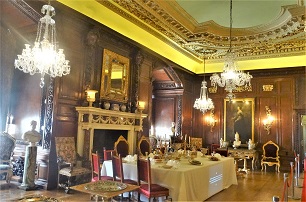 The Cedar Room is Italian in style and contains a gilded ceiling and marble walls. This room was used for festivities which included holding banquets in the late 17th century and for dancing in the late 19th century. The Green Drawing Room, with its coffered ceiling with octagonal sunken pane, served as a gentleman’s room. The portraits displayed show those who fought during the English Civil War. Warwick itself was parliamentary and the castle was used to hold royalist prisoners. The castle contains a number of other rooms both state and private which are on display providing a good insight into the history of the castle and the lives of the people and the times. 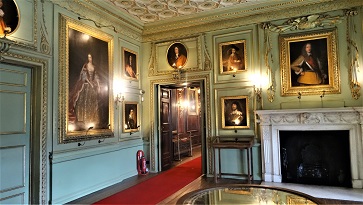 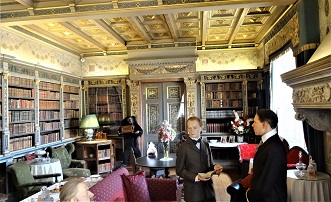 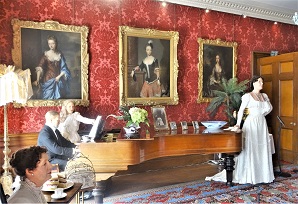 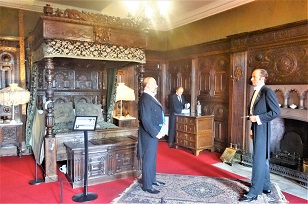 The chapel dates from the 17th century although there has been a chapel here as early as 1119. It contains a heraldic ceiling depicting the House of Greville. It is believed that this was installed in the 1740s. For many years the ceiling had been covered with whitewash, but during a restoration project in 1995, the shields came to light. The room also contains a 14th century stained glass window which was given to the Earl of Warwick in 1759. A stone screen wall segregated the servants who would also worship there. The State Dining Room has been used since 1763 and has hosted many famous guests including Queen Victoria and Queen Elizabeth II. Within this room is the famous Equestrian Portrait of Charles I (known as Charles I on Horseback) the oil painting on canvas by Anthony van Dyck. 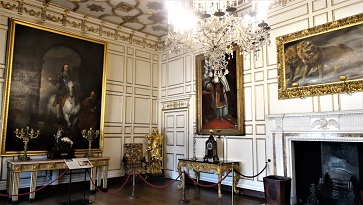 Visitors have been visiting the castle since the end of the 17th century but in 1885 they were stopped for a period. In 1900 it had once again opened and even had a ticket office and a guide to take visitors around. Throughout the 20th century, its role as a tourist attraction increased and in 1978 it was purchased by the Tussauds Group a media and entertainment company, and in 2017 it was purchased by the Blackstone Group. Warwick Castle is considered to be one of Britain's top historic houses and monuments and today is geared up to visitors with many rooms containing wax models of the people who once habited the castle. The dungeons have atmospheric displays and role-play to entertain and educate. |
|
|||
|
|
|||||
All Photographs were taken by and are copyright of Ron Gatepain
| Site Map |